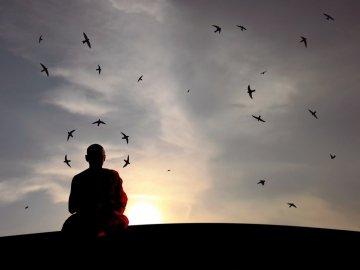On a warm, hazy afternoon, people cross the iron footbridge on bikes, foot or horseback. I sit about 75 meters upstream from the bridge. And though I’m in the open, few passersby see me either from the bridge, or the narrow park road across and above the stream.
 The water ripples with washboard effect in this section of the stream, masking most of the noises from vehicles passing irregularly on the road adjacent to the park. Occasionally an especially loud car or truck, or the throbbing bass of a boom box, penetrate the stillness, but the noise does not disturb, much less disrupt the inclusive awareness of meditation.
The water ripples with washboard effect in this section of the stream, masking most of the noises from vehicles passing irregularly on the road adjacent to the park. Occasionally an especially loud car or truck, or the throbbing bass of a boom box, penetrate the stillness, but the noise does not disturb, much less disrupt the inclusive awareness of meditation.
I look up to see a female mallard less than five meters downstream. She is lingering warily along the bank, treading the gentle current. I can feel her awareness of me, and don’t move. She inches closer in the next few minutes. Suddenly she bursts into the air with such explosiveness that drops rain onto my skin.
Doing nothing—simply intensely and undividedly observing everything that is happening outwardly and inwardly—is the highest action. Doing so initiates the movement of negation, the unwilled dissolving of patterned thoughts and accumulated emotions, and is the pathless path to illumination. It’s called ‘via negativa’—the negative way.
It’s also an essential action for health of the mind and body, since for the organism to operate optimally, it has to regularly be emptied of accretions. That’s as true mentally and emotionally as it is physically. Mental accumulation is not just a matter of ‘information overload,’ but of absorbing toxic content of which one is unaware.
Being mindful of emotional and mental accumulation, and allowing it to flow forth into awareness and be released from the mind and body by simply attending to it, is the process of negation in meditation.
Unless one is actually in a meditative state of awareness, experience leaves a residue of which we are not entirely aware. For example, we’ve all had experiences where we think we’re having a good conversation with a group of people, but someone makes a cutting remark, perhaps unintentionally, which ‘sticks in our craw.’ We often don’t realize it until later, when we feel angry but aren’t sure exactly why.
There are three approaches to such incidents, or much worse ones. One can, as most people do, push the offending remark or experience away and push on, telling ourselves ‘it’s nothing and it doesn’t bother me.’ In this way, one becomes oblivious to what is going on within one, and develops into the kind of person that made the thoughtless remark.
The second approach is to analyze one’s delayed reactions, try to intellectually understand them, and thereby control one’s emotions. This ‘top down’ method, the cornerstone of talk therapy, works to a point, but doesn’t quiet and empty the accumulative, calculating mind.
A third approach is to simply passively observe the stream of one’s consciousness, watching without interference or judgment thoughts and feelings that arise while sitting in nature (even if just the backyard), not trying to alter, explain or label the flow.
When undirected attention gathers intensity, this approach quiets the mind and empties the heart. I think it would work even for people suffering from post-traumatic stress.
from post-traumatic stress.
The mind stores experiences, some of which are imprinted on the emotional centers in the brain. If one knows how to observe the movement of oneself, experiences spontaneously unfold, and tell their story. Observing without the observer—that is, without separation and control—useless memories and emotional hurts are negated, even deleted.
It isn’t easy, but this is the healthiest way of living, and remaining young in mind and heart. Of course it requires understanding right observation, which is completely undivided and unwilled. It also requires taking a little time every day to sit and passively and energetically watch the mind and emotions without interference or judgment.
Like one fish turning to another fish and saying ‘what water?’ most people, especially in hyper-individualized societies, aren’t aware of the culture—the sea in which we all swim. That’s also true in the few remaining communal cultures, where traditions and assumptions are implicitly shared in a non-fragmented way. We can’t go back however. Awareness is the way ahead.
Recently in California, many animals at the top of the food chain—otters, seals, birds, dolphins, and even whales—have been washing up dead on the Pacific coast. Scientists think this disturbing phenomenon, whose immediate cause appears to be toxic algae growth, is the result of many factors—pollution, warming of the oceans, over-fishing, environmental stress, etc.
It’s both a metaphor and physical expression of the cumulative effects of the buildup of poisons from and in human consciousness. Without regularly initiating the movement of negation, accumulations build up to toxic levels—in the environment, and within us.
Martin LeFevre

